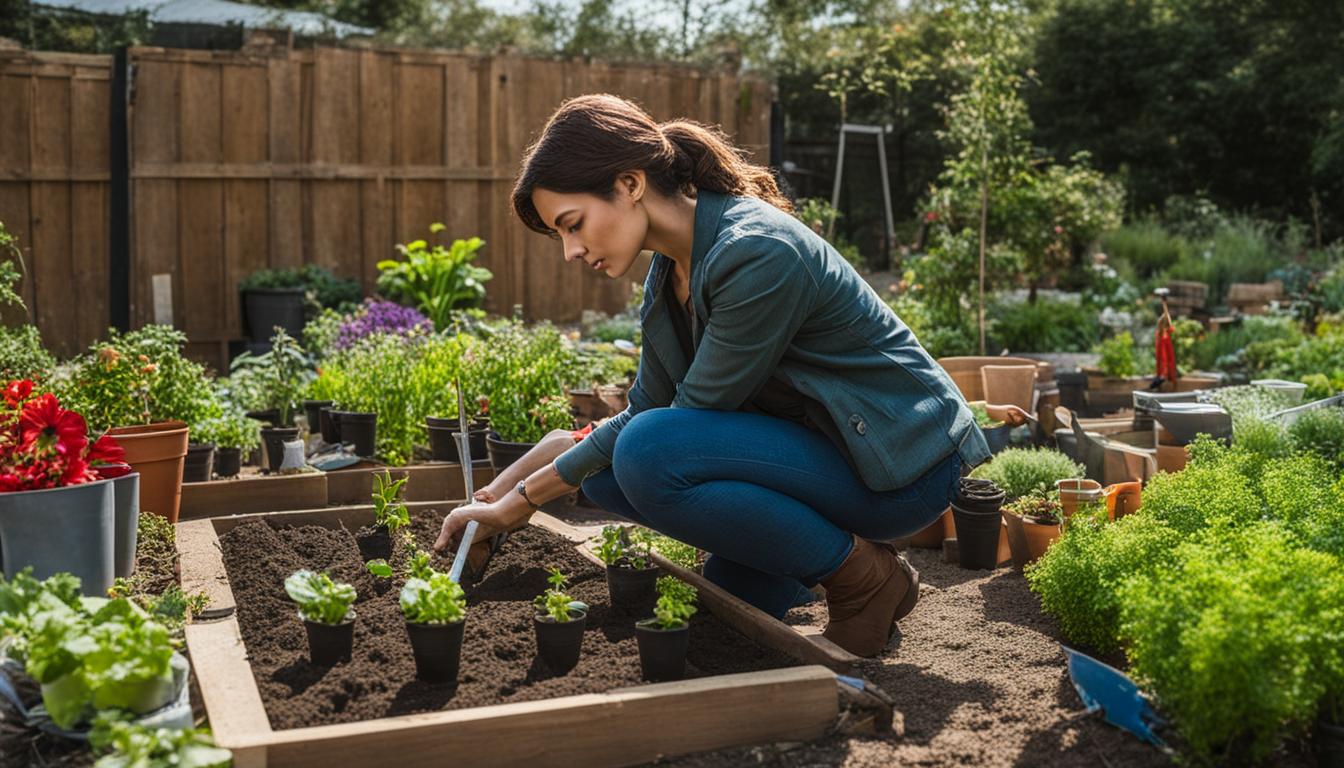In late March, interest in growing a garden hit an all-time high, according to Google Trends. People were craving a smart solution to address the food supply anxiety caused by the coronavirus outbreak. Good Housekeeping saw a nearly 200% increase in interest around gardening content in May 2020 compared to the previous year. Whether you desire to exercise your creativity, boost your home’s curb appeal, or lead a healthier lifestyle, starting a garden from scratch is a fun way to accomplish these goals. It also offers health benefits such as lowering blood pressure and lifting your mood. Having a garden as a novice requires patience and basic knowledge of plant types, soil care, and essential tools.
Key Takeaways:
- Starting a garden provides a creative outlet and offers physical and mental health benefits.
- Patience, knowledge of plant types, soil care, and essential tools are necessary for successful gardening.
- Gardening can enhance your home’s curb appeal and provide a source of fresh, healthy produce.
- Good Housekeeping saw a nearly 200% increase in interest around gardening content in May 2020.
- Having a garden is a fun way to exercise your creativity and lead a healthier lifestyle.
The Benefits of Gardening for Beginners
Gardening is not only a popular hobby but also a rewarding and therapeutic activity, especially for beginners venturing into this green world. As a beginner gardener, you can experience numerous benefits while nurturing your own little green haven.
According to Gwenn Fried, manager of Horticulture Therapy at NYU Langone’s Rusk Rehabilitation, spending time in a calm and green environment can significantly improve your overall well-being and lower cortisol levels. Gardening provides the perfect opportunity to connect with nature, reducing stress and offering a sense of accomplishment.
But the benefits go beyond just mental well-being. When you start a garden, you embark on a journey of creativity and self-expression. Gardening allows you to explore your creative side as you choose plants, arrange them, and design your garden space. It’s a chance to create something beautiful and unique.
Additionally, gardening is a great way to increase physical activity. Whether it’s digging, planting, or weeding, these activities engage your body and provide a healthy dose of exercise. It’s a fantastic way to maintain an active lifestyle while enjoying the beauty of plants and flowers.
Moreover, gardening opens up a world of learning and discovery. As a beginner, you’ll gain knowledge about different plant types, their growth requirements, and how to care for them. You’ll develop a deeper understanding of the natural world, and each day in your garden presents an opportunity to learn something new.
I find solace and inspiration in my garden. It allows me to unwind, connect with nature, and create a personal sanctuary. Gardening truly is a rewarding experience for beginners like me.
In conclusion, gardening offers a multitude of benefits for beginners. It’s a journey of self-discovery, relaxation, creativity, and physical activity. So, grab your gardening tools, put on your gloves, and get ready to embark on this fulfilling adventure.
Developing a Gardening Mindset
When it comes to gardening, it’s not just about getting your hands dirty and planting seeds. Developing a gardening mindset is essential for success, and it involves a combination of education, record-keeping, and cultivating specific qualities like curiosity, patience, and a sense of humor.
One of the first steps in developing a gardening mindset is to educate yourself about gardening techniques. Investing in gardening books and reliable online resources can provide valuable knowledge about plant care, soil preparation, and pest control. Continuously expanding your gardening education will help you make informed decisions and improve your gardening skills over time.
Keeping good records is another important aspect of maintaining a gardening mindset. By documenting your observations, successes, and failures, you can learn from past experiences and make adjustments accordingly. These records can include details about plant growth, soil quality, and the effectiveness of different gardening methods. By referring back to your records, you can track your progress and make more informed decisions in the future.
Furthermore, being curious and patient is crucial for a successful gardening journey. Curiosity fuels a desire to learn and explore new gardening techniques, while patience allows you to navigate challenges and setbacks. Gardening is a constant learning process, and having a growth mindset will help you adapt and overcome obstacles along the way.
A sense of humor is also an essential ingredient in the gardening mindset. Embracing the unexpected outcomes and inevitable failures with a lighthearted approach can make the gardening experience more enjoyable. After all, gardening is a journey filled with surprises, and laughter can be the best medicine when things don’t always go as planned.
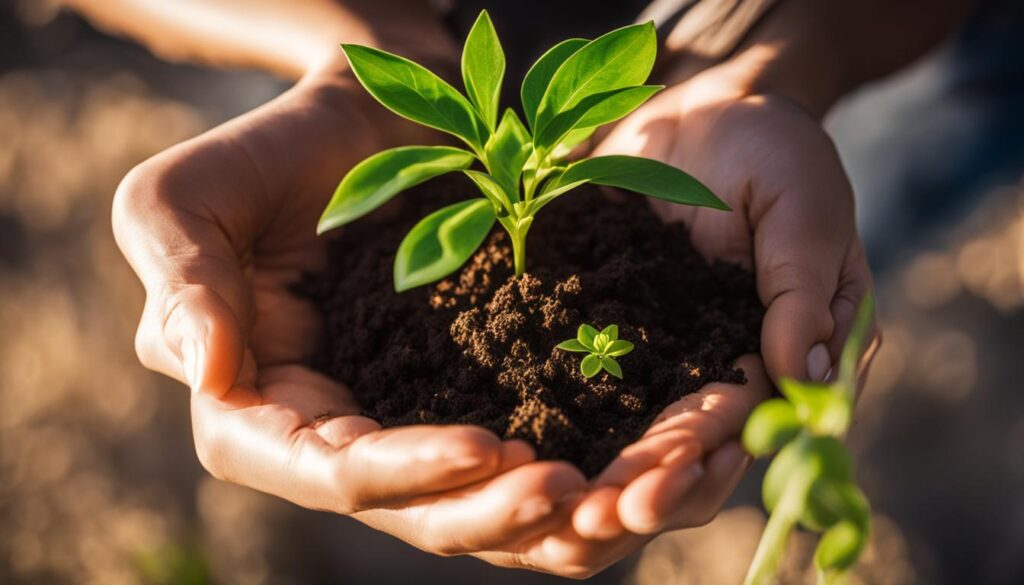
“Gardening requires lots of water – most of it in the form of perspiration.” – Lou Erickson
Choosing the Right Location for Your Garden
Selecting the right location for your garden is crucial. A well-chosen garden location sets the stage for healthy plant growth and successful gardening endeavors. Here are some important factors to consider when deciding on the perfect spot for your garden:
- Visibility and Accessibility: Choose an area of your yard that is visible and easily accessible. This ensures that you can easily monitor and tend to your plants without any inconvenience.
- Sunlight: Consider the sunlight patterns in your yard. Most plants require at least 6 hours of direct sunlight daily to thrive. Choose a spot that receives ample sunlight throughout the day.
- Water Source: Plan your garden near a water source to ensure easy watering. Having a water source nearby eliminates the hassle of carrying water to your plants and provides convenient access to the essential element they need to grow.
By carefully considering these factors, you can create an ideal garden location that provides your plants with the necessary sunlight and easy access to water.
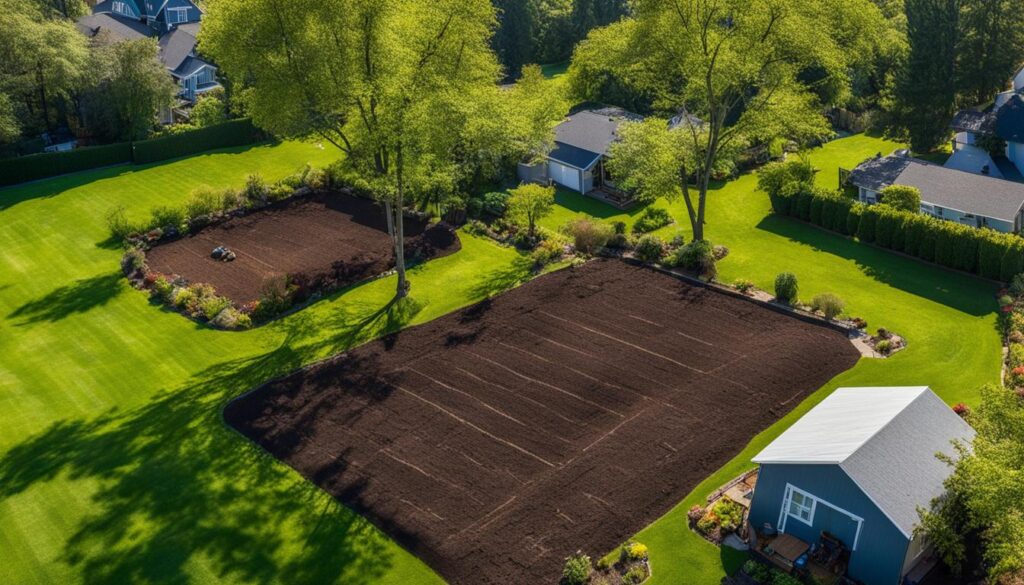
With a well-chosen garden location, you’ll be on your way to a thriving garden filled with vibrant and healthy plants.
Soil Preparation for a Successful Garden
When it comes to starting a garden, one of the most crucial factors to consider is the soil. Whether you’re planning to plant directly in the ground or use raised bed gardening, proper soil preparation is key to ensuring healthy plant growth and optimal nutrient absorption.
To create a nutrient-rich environment for your garden, I recommend incorporating Miracle-Gro All Purpose Garden Soil. This high-quality soil is specially formulated to provide the essential nutrients and minerals that plants need to thrive.
For Ground Planting
If you’re planting directly in the ground, here’s how to prepare your soil:
- Remove any weeds or rocks from the planting area.
- Loosen the soil to a depth of 6-8 inches using a garden fork or shovel.
- Incorporate 3 inches of Miracle-Gro All Purpose Garden Soil into the top 6-8 inches of the existing soil.
- Ensure the soil is well-mixed and evenly distributed.
This process will enrich your soil with essential nutrients, improving its fertility and overall quality. It will also enhance drainage and aeration, creating an optimal growing environment for your plants.
Raised Bed Gardening
If you prefer raised bed gardening, which is a popular option for small spaces or areas with poor soil quality, Miracle-Gro Raised Bed Soil is the perfect choice. This specially formulated soil is designed to provide the ideal growing conditions for plants in raised beds.
To prepare your raised bed:
- Fill the raised bed with Miracle-Gro Raised Bed Soil, ensuring it is evenly distributed.
- Smooth the soil surface using a rake or gardening tool.
Raised bed gardening offers several advantages, including better control over soil quality and drainage, reduced weed growth, and easier maintenance. By using Miracle-Gro Raised Bed Soil, you’ll create an optimal growing environment for your plants, setting them up for success.
Remember, good soil preparation is essential for a successful garden. By using nutrient-rich soil like Miracle-Gro All Purpose Garden Soil or Miracle-Gro Raised Bed Soil and following the recommended techniques, you’ll provide your plants with the foundation they need to thrive.
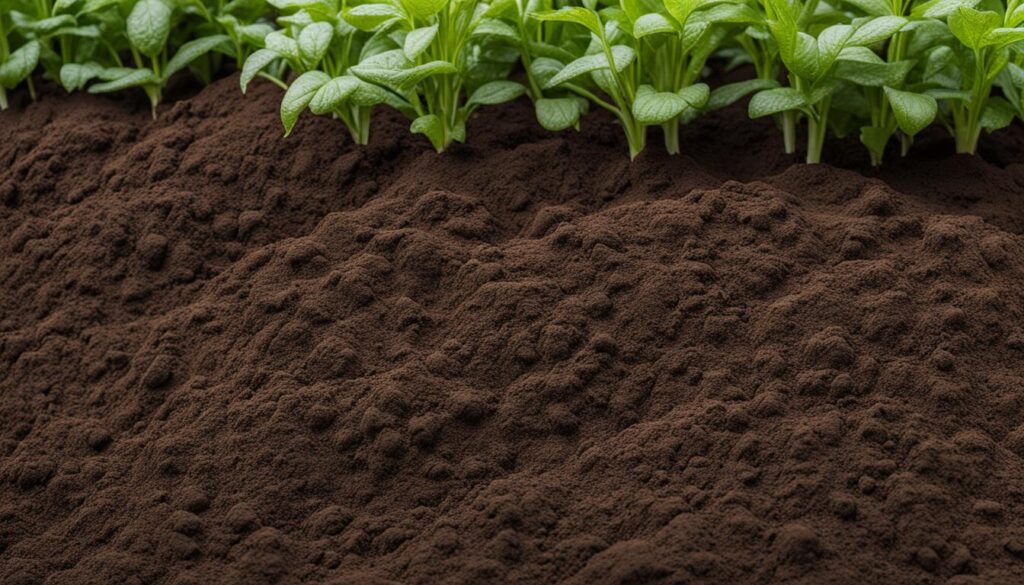
Container Gardening for Small Spaces
Container gardening is a great solution for those with limited space, allowing you to grow a variety of plants in pots. Whether you have a small balcony, a tiny patio, or no backyard at all, containers can turn any space into a beautiful garden.
With container gardening, you have the flexibility to grow vegetables, herbs, flowers, and even small fruit trees right on your doorstep. It’s a convenient and accessible way to bring nature closer to you and enjoy the benefits of gardening.
When choosing containers, opt for ones that can accommodate the size of your plants. The container should provide enough space for the plant’s roots to grow and spread. Additionally, it’s important to ensure proper drainage by having holes at the bottom of the pot.
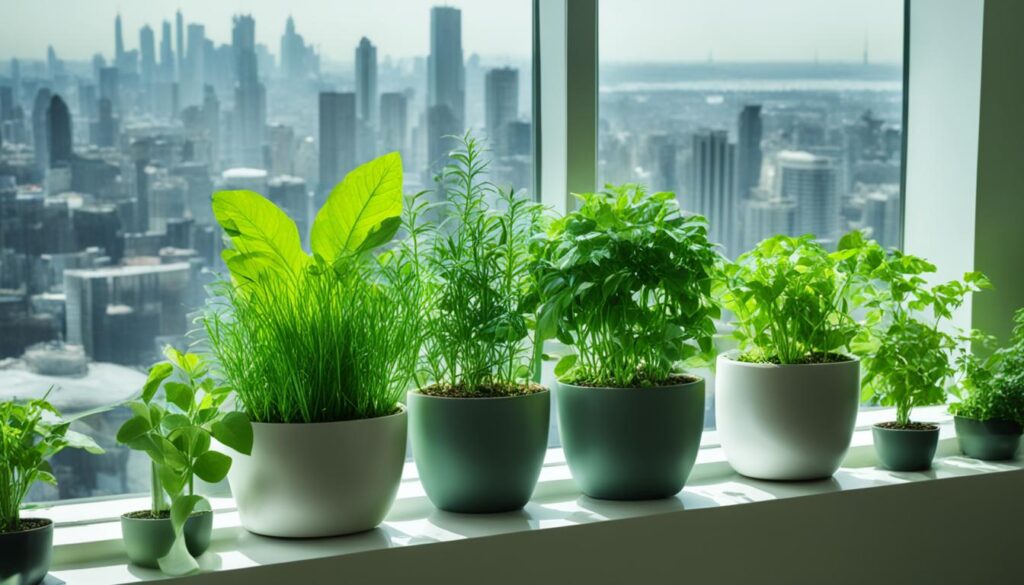
To create a conducive environment for your plants, fill your containers with Miracle-Gro Moisture Control Potting Mix. This potting mix is specially formulated for container gardening and helps regulate water absorption, preventing under or over-watering. It also contains essential nutrients that promote healthy plant growth.
Container gardening offers numerous advantages, including:
- The ability to grow plants even in small spaces
- Flexibility to move containers and adjust their position as needed for optimal sunlight
- Reduced risk of pests and diseases compared to traditional garden beds
- Easy maintenance and accessibility for watering and tending to plants
“Container gardening is a versatile and rewarding way to enjoy gardening in small spaces. It allows individuals to create their own personalized oasis, no matter how limited their outdoor area may be.”
If you’re looking for a way to brighten up your small space, container gardening is the perfect solution. Whether you’re growing fresh herbs for your culinary adventures or adding a splash of color with vibrant flowers, container gardening offers endless possibilities.
Selecting the Right Plants for Your Garden
When it comes to creating your garden, selecting the right plants is essential. Choosing plants that suit your growing conditions ensures a thriving and beautiful garden. Whether you have a sunny spot or a warm climate, there are plants that will flourish in your garden. Here are some tips to help you make the best plant selections.
1. Consider Growing Conditions: Take into account the sunlight and temperature conditions in your garden. Opt for sun-loving plants if your garden receives ample sunlight, and choose heat-tolerant varieties if you live in a warm climate. By choosing plants that align with their preferred growing conditions, you set them up for success.
2. Evaluate Space: Some plants, like pumpkins and melons, require more space to spread and grow. Make sure you provide ample room for these plants or consider using a trellis for them to climb. Assess the space you have available and select plants that fit well in your garden area.
3. Research Plant Varieties: Research different plant varieties to find those that are suitable for your area. Consider factors such as the length of the growing season, disease resistance, and adaptability to your climate. Look for plant options that are beginner-friendly and have a higher chance of success for novice gardeners.
4. Start with Young Plants: Starting with young plants rather than seeds can increase your chances of success, especially if you’re a beginner. Young plants are more resilient and have a better chance of adapting to their new environment. Additionally, they require less care and offer a quicker start to your garden.
By carefully selecting the right plants for your garden, you set yourself up for a thriving and healthy garden. Take into account the growing conditions, available space, and plant varieties that are best suited for your area. Starting with young plants can also increase your chances of success as a beginner gardener.
Understanding Your Hardiness Zone
Knowing your hardiness zone is essential when planning your garden, as it helps you determine which plants are suitable for your area. Your hardiness zone is determined by the average minimum winter temperature in your region, indicating the hardiness of plants in that climate.
Higher zone numbers generally indicate warmer climates, while lower numbers represent colder regions. For example, Zone 1 experiences the coldest temperatures, while Zone 13 enjoys a tropical climate.
If you’re unsure about your hardiness zone, you can refer to the USDA Plant Hardiness Zone Map, which provides a detailed overview of hardiness zones across the United States. It’s important to match plants labeled “hardy to zone X” with your specific zone number to ensure successful growth.
In addition to your hardiness zone, it’s crucial to consider the average first and last frost dates in your area. These dates help determine the appropriate timing for planting and ensure your plants have the best chance to thrive.
Importance of Mulching
When it comes to nurturing your garden, mulching plays a vital role in promoting healthy plant growth and managing unwanted weeds. Applying a layer of garden mulch around each plant offers a range of benefits, including weed control and moisture retention.
“Mulching is like a protective blanket for your garden. It helps to keep the soil moist, reduces weed growth, and maintains a more stable soil temperature.” – Gardening expert
Mulching works by blocking out sunlight from reaching the soil surface, which inhibits weed germination and growth. By reducing weed competition, your plants can fully utilize the available resources and thrive. Additionally, mulching also acts as a barrier, preventing weed seeds from blowing into your garden beds.
Another advantage of garden mulch is its ability to retain moisture in the soil. By covering the soil surface, mulch minimizes evaporation, allowing plants to access water for a longer duration. This not only reduces the frequency of watering but also ensures that your plants receive a consistent water supply, even during hot summer days.
Types of Mulching Materials
There are several options for mulching materials, depending on your garden’s unique needs and aesthetics. Some popular choices include:
- Scotts bagged mulch
- Straw
- Shredded leaves
- Pine straw
Each material offers specific benefits and features, such as different rates of decomposition and nutrient enrichment. Consider your plant’s requirements and the overall look you want to achieve in your garden when selecting the mulching material.
Remember to apply mulch at a depth of 2-3 inches around each plant, ensuring the material doesn’t touch the stem. This will provide optimal protection against weeds and help retain moisture effectively.
With the strategic use of mulch, you can create a healthier garden environment, free of weeds and with improved moisture retention. Start mulching your garden today and enjoy the benefits it brings!
| Benefits of Mulching | Material | Rate of Decomposition | Nutrient Enrichment |
|---|---|---|---|
| Weed control | Scotts bagged mulch | Slow to moderate | Minimal |
| Water retention | Straw | Fast | Low |
| Moisture conservation | Shredded leaves | Slow | Rich in organic matter |
| Weed suppression | Pine straw | Slow to moderate | Low |
Feeding and Nurturing Your Garden
Proper plant nutrition is essential for the healthy growth of your garden. To ensure your plants thrive, it is important to provide regular feeding and nourishment. By using the right plant food, such as Miracle-Gro Water Soluble All Purpose Plant Food, you can supply the necessary nutrients for vibrant and strong plants.
Feeding your garden should begin approximately a month after planting. At this stage, the plants have established their root systems and will benefit from the additional nutrition. Follow the label instructions on the plant food packaging for the proper application rate.
By feeding your garden regularly, you can support optimal plant growth and development. The balanced nutrients provided by plant fertilizers help plants produce more flowers, fruits, and vegetables. These nutrients also contribute to the overall health and vigor of your garden.
Remember to choose a plant food that suits the needs of your plants. Miracle-Gro Water Soluble All Purpose Plant Food is a versatile option that can be used for a wide variety of plants, including flowers, vegetables, herbs, and shrubs.
Additionally, consider the specific nutritional requirements of different types of plants. Some plants may benefit from specific formulas, like Miracle-Gro Tomato Plant Food for tomato plants or Miracle-Gro Rose Plant Food for roses.
Nutrients Essential for Plant Growth
Plants require a variety of nutrients for healthy growth. The three primary nutrients are:
- Nitrogen (N) – promotes leaf and stem growth
- Phosphorus (P) – stimulates root development, flowering, and fruiting
- Potassium (K) – supports overall plant health, including resistance to disease and stress
In addition to these primary nutrients, plants also require secondary nutrients like calcium, magnesium, and sulfur, as well as micronutrients such as iron, manganese, and zinc.
Using a balanced plant food like Miracle-Gro Water Soluble All Purpose Plant Food ensures your plants receive the necessary nutrients for optimal growth and productivity.
| Nutrient | Role in Plant Growth | Symptoms of Deficiency |
|---|---|---|
| Nitrogen (N) | Promotes leaf and stem growth | Yellowing leaves, stunted growth |
| Phosphorus (P) | Stimulates root development, flowering, and fruiting | Poor root growth, delayed flowering |
| Potassium (K) | Supports overall plant health, resistance to disease and stress | Weak stems, leaf discoloration |
| Calcium (Ca) | Aids in cell wall formation and root development | Leaf tip burn, blossom end rot |
| Magnesium (Mg) | Essential for chlorophyll production | Yellowing between leaf veins |
| Sulfur (S) | Contributes to protein synthesis and enzyme activity | Yellowing leaves |
Providing the right nutrients in the right amounts is crucial for maintaining healthy plants. By assessing the specific needs of your garden and using a reliable plant food, you can ensure your plants receive the essential nutrition they require.
Essential Gardening Tools
When it comes to gardening, having the right tools can make all the difference in creating a successful and enjoyable experience. Whether you’re a beginner or an experienced gardener, having essential gardening equipment on hand is essential for maintaining and beautifying your garden. Here are some tools every gardener should have:
- Trowel: A trowel is a must-have tool for planting and transplanting flowers, vegetables, and herbs. It’s a small handheld tool with a pointed end and a scoop-shaped blade, perfect for digging small holes and moving soil.
- Gardening gloves: Protect your hands from thorns, rough surfaces, and dirt with a good pair of gardening gloves. Look for gloves that provide a snug fit, excellent grip, and durability.
- Pruning shears: Trimming and shaping plants is made easy with pruning shears. These handheld tools are designed to cut small branches and stems cleanly and precisely. They are essential for maintaining the health and appearance of your plants.
- Watering can or hose: Adequate watering is crucial for the growth and development of your plants, so having a watering can or hose is essential. Choose a watering can for smaller gardens or a hose for larger areas.
- Shovel: A durable shovel is necessary for tasks such as digging large holes, moving soil, and mixing compost. Look for a shovel with a comfortable grip and a strong, sturdy blade.
With these essential gardening tools, you’ll be equipped to handle a variety of gardening tasks with ease. Remember to choose tools that are comfortable to use and of good quality, as they will last longer and provide better results.
Gardening Tip: Organize Your Tools
To stay organized and prevent any tools from getting misplaced, consider using a garden tool storage system or a designated area in your shed or garage. This will help you keep track of your tools and ensure they’re readily available when you need them.
Now that you have the essential gardening tools, you’re ready to take on any gardening project with confidence. Get your hands dirty and start creating the garden of your dreams!
| Gardening Tool | Description |
|---|---|
| Trowel | A handheld tool with a pointed end and scoop-shaped blade, used for digging small holes and moving soil. |
| Gardening gloves | Protective gloves designed to shield your hands from thorns, rough surfaces, and dirt. |
| Pruning shears | Handheld tools used for trimming and shaping plants by cutting small branches and stems. |
| Watering can or hose | Essential for providing adequate water to your plants, choose a watering can for smaller gardens or a hose for larger areas. |
| Shovel | A tool with a strong, sturdy blade, used for digging large holes, moving soil, and mixing compost. |
Conclusion
Starting your own garden, even without a green thumb, is an achievable and rewarding endeavor. By following the tips and steps outlined in this guide, beginners can successfully create and nurture a garden. Remember to educate yourself, select the right location and plants, prepare the soil, provide proper care and nutrition, and enjoy the process of watching your garden grow. Happy gardening!
FAQ
What are the benefits of starting a garden?
Starting a garden offers many benefits, including the opportunity to connect with nature, reduce stress, and enjoy the beauty of plants and flowers. It also provides a sense of accomplishment and can improve physical health and well-being.
How can I develop a gardening mindset?
Developing a gardening mindset involves educating yourself about gardening techniques, keeping good records, and maintaining curiosity, patience, and a sense of humor. Investing in gardening books and online resources, keeping records of your observations, and being curious and patient will help you improve your gardening skills over time.
What should I consider when choosing the location for my garden?
When choosing the location for your garden, consider placing it in an area of your yard that is visible and easily accessible. Make sure the spot receives at least 6 hours of direct sunlight daily and is near a water source for easy watering.
How should I prepare the soil for my garden?
Start with nutrient-rich and well-drained soil for a successful garden. Incorporate 3 inches of Miracle-Gro All Purpose Garden Soil into the top 6-8 inches of existing soil for ground planting. For raised bed gardening, use Miracle-Gro Raised Bed Soil, specially formulated for raised beds. Good soil preparation ensures healthy plant growth and optimal nutrient absorption.
Can I have a garden in small spaces?
Yes, you can have a garden in small spaces by using containers. Containers are an excellent option for gardening in limited areas. You can grow various plants in pots, including vegetables, herbs, flowers, and even fruit trees. Use a pot that accommodates the plant’s size and fill it with Miracle-Gro Moisture Control Potting Mix, which helps plants thrive in containers and regulates water absorption.
How do I choose the right plants for my garden?
Choose plants that suit your growing conditions, such as sun-loving plants for sunny spots and heat-tolerant plants for warm climates. Consider the space required by plants like pumpkins and melons and provide ample room or a trellis for them to climb. Research plant varieties that are suitable for your area and start with young plants for greater success.
How do I know which plants are suitable for my area?
Knowing your hardiness zone helps you determine which plants are suitable for your area. Higher zone numbers indicate warmer climates. Match plants labeled “hardy to zone X” with your zone number for successful growth. Consider the average first and last frost dates in your area to ensure appropriate planting times.
Why is mulching important for my garden?
Mulching is important because it reduces weed growth and moisture loss through evaporation. Applying a 2-3 inch layer of mulch around each plant blocks out sunlight, preventing weed growth, and helps retain moisture in the soil, reducing the frequency of watering. Options for mulching materials include Scotts bagged mulch, straw, shredded leaves, or pine straw.
How can I provide proper nutrition for my garden?
To provide regular plant nutrition, start feeding your garden with a plant food like Miracle-Gro Water Soluble All Purpose Plant Food about a month after planting. Follow label instructions for proper application. Proper nutrition will support strong and vibrant plant growth, leading to a successful garden.
What are some essential gardening tools I should have?
Some basic tools every gardener should have include a trowel, gardening gloves, pruning shears, a watering can or hose, and a shovel. Having the right tools on hand will help you perform necessary tasks and maintain your garden with ease.
Can I start a garden even if I don’t have a green thumb?
Yes, starting your own garden is an achievable and rewarding endeavor, even if you don’t have a green thumb. By following the tips and steps outlined in this guide, beginners can successfully create and nurture a garden. Remember to educate yourself, select the right location and plants, prepare the soil, provide proper care and nutrition, and enjoy the process of watching your garden grow.

